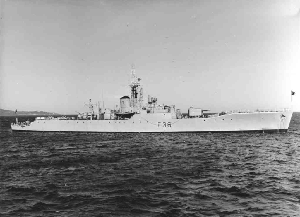INS Trishul (1960)

HMS Whitby. She has the modified funnel form and a unique, flat bridge face.
|
|
| Class overview | |
|---|---|
| Name: | Whitby class |
| Builders: | |
| Operators: | |
| Preceded by: | Type 11 (never built) |
| Succeeded by: | Rothesay class |
| In commission: | 10 May 1956 – 21 March 1985 (RN) |
| Completed: | 6 + 2 Indian |
| General characteristics | |
| Type: | Frigate |
| Displacement: | |
| Length: | |
| Beam: | 41 ft (12 m) |
| Draught: | 17 ft (5.2 m) |
| Propulsion: | Y-100 plant; 2 Babcock & Wilcox boilers, 2 English Electric steam turbines, 2 shafts, 30,000 shp (22,000 kW) |
| Speed: | 30 kn (56 km/h) |
| Range: | 370 tons oil fuel, 4,200 nmi (7,780 km) at 12 knots (22 km/h) |
| Complement: | 152, later 225 |
| Sensors and processing systems: |
|
| Armament: |
|
The Type 12 or Whitby-class frigates were a six-ship class of anti-submarine frigates of the British Royal Navy, which entered service late in the 1950s. They were designed in the early 1950s as first-rate ocean-going convoy escorts, in the light of experience gained during World War II. At this time, the Royal Navy were designing single-role escorts and the Whitbys were designed as fast convoy escorts capable of tackling high-speed submarines. However, this made the Whitbys more expensive and sophisticated to produce in large numbers in the event of a major war, and so the Type 14 "utility" or "second-rate" anti-submarine frigate was developed to complement the Type 12. Although themselves rapidly outdated, the Type 12 proved to be an excellent basis for a series of frigate designs used by the British and Commonwealth navies for the next 20 years.
Critical to the design of the Type 12 was the capability to steam for long periods of time in heavy seas, economically and at high speed. For this reason a novel hull form was devised, which despite appearance, was totally unrelated to that of the earlier Type 41 / Type 61 design. The hull showed the fine lines more typical of a destroyer, but had a raised forecastle with considerable flare. The fo'c'sle deck was level to maintain maximum freeboard aft of the stem where it is most likely that waves will break across the deck. These two features meant that the hull not only cut through the water, but that spray was thrown upwards and outwards, away from the bridge and gun turret. This was especially important in high latitudes where war experience had shown that spray could cause rapid and undesirable ice build-up on the forecastle. The deck edges and hull also met at a curve rather than an angle, the anchors were recessed, and protrusions were kept to a minimum to limit the potential sources of ice build-up and spray generation. The Mark 6 gunhouse was large and heavy, so had to be carried low to maintain stability and give a good view over it from the bridge. The forecastle therefore had a very distinctive kink, allowing the position of the guns to be lowered. This had the added benefit of moving the bridge aft, where there was considerably less motion, improving the lot of the watchkeeper. The hull form, coupled with a twin-shaft double-reduction geared steam turbine plant (the Y-100) that operated at high temperature and pressure (for efficiency) and low revolutions, with new five-bladed low-cavitation propellers (for efficiency and quietness) lent themselves to the perfect hull for a high-speed, all-weather anti-submarine vessel.
...
Wikipedia
